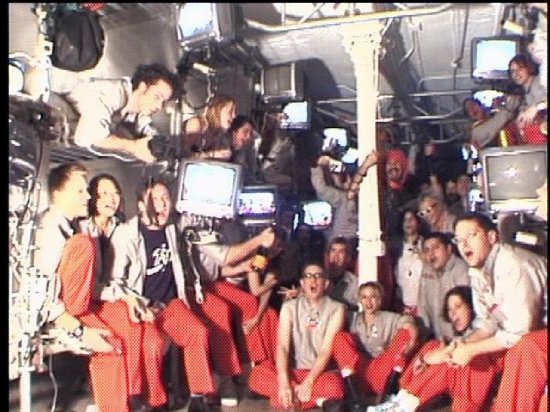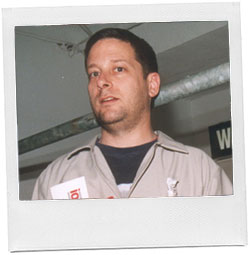
The recent commercial release of We Live In Public, a documentary film by Ondi Timoner (which won a Grand Prize at Sundance in January and also screened in April at New Directors/New Films at MoMA), has focused attention on Josh Harris, the erstwhile dot.com millionaire who presided over Jupiter Communications and Pseudo TV, and who funded various downtown New York arts projects in the late 90s and early noughties, culminating (at least for me) with QUIET: We Live in Public.
QUIET was a heady but deranged bit of social sculpture, enlisting 150 artist/participants to live communally in a bunker housed on three floors of a loft building at 353 Broadway at the end of 1999. It envisioned a Brave New World of surveillance, control and loss of privacy, both predicted and facilitated by the Internet. Harris imagined that these long standing dystopian issues would be given technological feasibility through an interlocking network of computers and webcams. It would re-invigorate the pan- in Panopticon.

Harris now ^^ and then v v.

Harris had the prescient, net head epiphany of an early adopter, imagining a world of online social networking before there was actual broadband technology to make it possible. His vision, conceptualizing the emergence of all-encompassing public interaction online, predicted Web 2.0 sites like MySpace, YouTube and Facebook a decade early.
In December 1999, I was one of the pod people, living in a sub-basement warren of tiered sleeping capsules, like a Japanese tourist hotel or something out of William Gibson, sleeping pallets with room for just a mattress and alarm clock. Each was also equipped with its own camera and pivoting TV monitor. We could not only tune into various live feeds being recorded and broadcast within the compound. We were also constantly on camera, producing our own flow of images. Anyone at the central control booth could watch as we ate, shat, argued, made art, fucked, etc. Theoretically, anyone in the bunker, at any time, could tune into anyone else in the bunker.

We were waiting for the Millennium to change everything, prepping for the mother of all New Year's parties. Because in late 1999, people thought the computers would inevitably crash when the clocks turned from 19__ to 20__. Things would just go plumb haywire. Data would be irretrievably lost. Banks would lose their assets. Credit would fail. It was supposed to be the end of time, the beginning of a New Age. We were there at the cusp to confront a devolved reality after the machines imploded and left us with a post-apocalyptic, feral, dog-eat-dog world.
This sort of Luddite anticipation was grafted onto the larger panopticon structure of QUIET. We were the self conscious seeds of a new dystopia, and there were cameras everywhere to record us. Even in the bathroom. Even in the central shower console, multiple nozzles housed in a polyhedral plexiglass cage, where there was sex.

(That's me, lower right.)
There were communal meals and uniforms, bright orange Dickies work pants and grey work shirts silkscreened with logos by the Enger Brothers, Matt and Mark. There were various art projects: a gigantic RISK board by David Scher and Mike Ballou; a modular city/shrine by Alex Arcadia; Erik Parker's paintings; a walk-in sculptural installation by Aidas Bareikis; a shooting gallery by Alfredo Martinez (for guns, not dope); security interrogations presided over by Ashkan Sahihi. The entire video interface was installed by Fakeshop pioneer Jeff Gompertz.

Of course the end of the world did not come, as predicted, at 00:00:00 on January 1, 2000. Things never happen quite so simply. Although the cops did raid the place on New Year's Day and shut it down, mostly for the live ammo being fired in the shooting gallery.

But the dot.com crash did not arrive until late 2000, when the first Internet bubble popped and wiped out most of Harris' fortune. By then he had wired his SoHo loft with over 30 cameras, so the total surveillance of QUIET became part of his daily life with his girlfriend. The toilet, the closet, the refrigerator each had its particular webcam. Things soon began to feel the strain.

Timoner's film, which I have not seen, is apparently merciless as it documents the implosion of Harris' personal life, while simultaneously according him the unquestioned status of a madman genius, an Internet idiot savant well ahead of his time. It also reveals him in his performance artist alter ego of "Luvvy", a shrieking clown with smeared makeup based on a character from the television sitcom Gilligan's Island, his favorite show growing up.

The film's very busy website, replete with downloadable widgets, Facebook and Twitter shares, screening information, theatrical dates, streaming video of interviews, photo albums, etc., is itself testimony to the total online connectivity and interactivity that Harris predicted. It includes this trailer:
Other recent coverage can be found on the New York Times, both a film review and a broader piece on Harris himself.
They say you can't go home again, but the release of We Live in Public brings me back to a moment when both the Internet and I were ten years younger. Or were we so much older then, are we younger than that now?

Being There and The Warhol Hijack
Hola,
Quiet de-lovely to see to this flick and indeed remember that moment in time. I remember being in one of the pods, extremely high and then at some point Diane Ludin and I decided we wanted to escape - probably about around 3 or 4 am. Just missing the bust. Also, I remember Fakeshop had named that project "Multiple Dwellings" and for a number of years Jeff Gompertz had a ticket from the NYC Fire Department with the phrase: "illegal Multiple Dwellings!"
This also brings to mind the "Warhol Hijack" that took the "We Live In Public Space" for 72 hours.
Public Notice:
On January 26-28, 2001, members of the Verbal group (new media artists Ricardo Dominguez, G.H. Hovagimyan, Yael Kanarek Tina LaPorta, Diane Ludin, Kevin & Jennifer McCoy, MTAA, Cary Peppermint and curator Jennifer Crowe) will be hijacking WeLiveInPublic.com, Josh and Tanya's loft in Soho that is wired to the Internet with 32 cameras. All sounds, events, and actions will be broadcast.
http://www.treasurecrumbs.com/verbal/wlip/